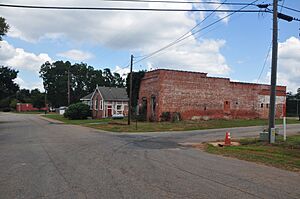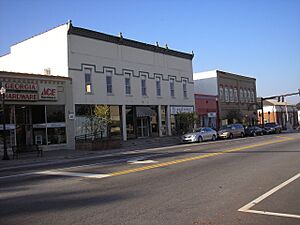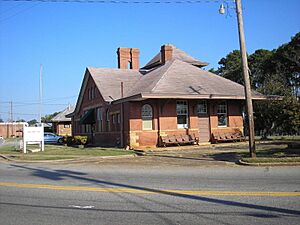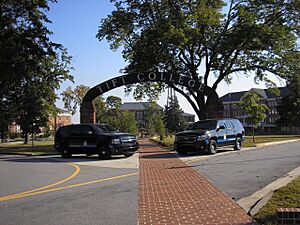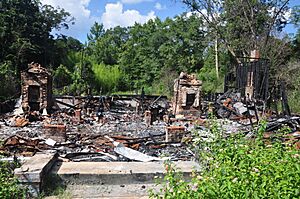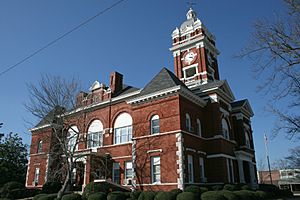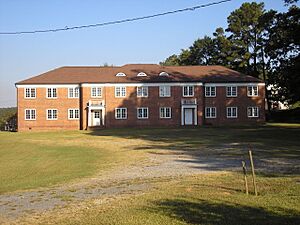National Register of Historic Places listings in Monroe County, Georgia facts for kids
This article lists cool and important places in Monroe County, Georgia that are part of the National Register of Historic Places. These places are special because they tell us stories about the past!
Contents
- What is the National Register of Historic Places?
- Historic Gems in Monroe County
- Culloden Historic District
- Forsyth Commercial Historic District
- Forsyth Railroad Depots and Baggage Room
- Front Circle, Tift College
- Great Hill Place
- Hil'ardin/Sharp-Hardin-Wright House
- Monroe County Courthouse
- Montpelier Female Institute
- State Teachers and Agricultural College for Negroes Women's Dormitory and Teachers' Cottage
What is the National Register of Historic Places?
The National Register of Historic Places (NRHP) is like a special list of buildings, sites, and areas across the United States. These places are important because they have a lot of history. They might be old homes, schools, churches, or even whole neighborhoods.
When a place is on the NRHP, it means it's recognized for its historical, architectural, or archaeological value. It helps protect these places so future generations can learn from them. It's a way to celebrate and keep alive the stories of our country.
Historic Gems in Monroe County
Monroe County has several amazing places listed on the National Register. Each one has its own unique history and charm. Let's explore some of them!
Culloden Historic District
The Culloden Historic District is a special area in the town of Culloden, Georgia. It was added to the list on March 13, 1980. This district includes many old buildings that show what the town looked like long ago. It's like stepping back in time when you walk through its streets.
Forsyth Commercial Historic District
In Forsyth, Georgia, you'll find the Forsyth Commercial Historic District. This area was recognized on January 13, 1983. It covers the main business streets of Forsyth. Many of the buildings here were once busy shops and offices. They show how people worked and traded in the past.
Forsyth Railroad Depots and Baggage Room
Also in Forsyth, Georgia, are the old Forsyth Railroad Depots and Baggage Room. These buildings became part of the NRHP on July 23, 2013. Train stations were very important long ago. They were hubs for travel and sending goods. These depots tell the story of how people and products moved around Georgia.
Front Circle, Tift College
The Front Circle, Tift College is another historic spot in Forsyth, Georgia. It was listed on February 8, 1980. Tift College was once a women's college. This "Front Circle" likely refers to an important part of the old campus. It reminds us of the history of education in the area.
Great Hill Place
Great Hill Place is located near Bolingbroke, Georgia. It was added to the National Register on July 24, 1973. This place is a historic property that has stood for many years. It represents the architecture and lifestyle of a past era in Monroe County.
Hil'ardin/Sharp-Hardin-Wright House
The Hil'ardin/Sharp-Hardin-Wright House is a historic home at 212 South Lee Street in Forsyth, Georgia. It joined the NRHP on June 22, 1979. Old houses like this one often have unique designs. They also hold many stories about the families who lived there over the years.
Monroe County Courthouse
The Monroe County Courthouse is a very important building in Forsyth, Georgia. It was listed on September 18, 1980. Courthouses are where local government happens. This building has seen many important decisions made for the county. It's a symbol of justice and community.
Montpelier Female Institute
The Montpelier Female Institute is a historic site located west of Macon, Georgia, but still within Monroe County. It was added to the NRHP on October 10, 1975. This institute was an early school for girls and young women. It played a big role in educating females in the region long ago.
State Teachers and Agricultural College for Negroes Women's Dormitory and Teachers' Cottage
This important site in Forsyth, Georgia, was listed on May 30, 2003. It includes the State Teachers and Agricultural College for Negroes Women's Dormitory and Teachers' Cottage. This college was very important for African American education. It helped many students learn and grow during a time when opportunities were limited.


